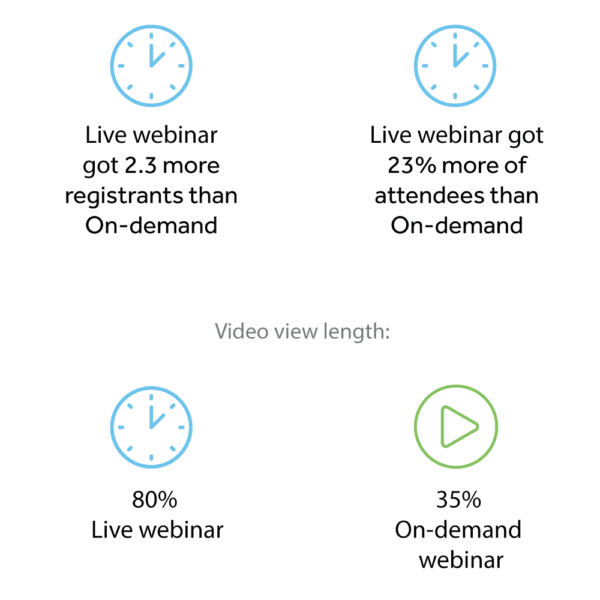We’ve recently decided to do an experiment to see whether an On-Demand webinar would attract more viewers than the typical approach of picking a date and broadcasting the webinar live.
We frequently hold “live webinars” and usually attract thousands of participants.
However, only about half of the viewers join the live session, while the rest watch the webinar after we send the recording. Considering how people enjoy instant access to content, we thought that by providing immediate access to the webinar, we might see better results. So, we chose to run a test.
During this tough time for everyone, we wanted to share our results as they might be helpful for you to engage with your audience by hosting webinars while most of us are working remotely and self-isolating.
Now is probably the best time to create more digital content to reach out to your customers.
Key Takeaways: Live vs On-Demand Webinar
- Live webinars outperform on-demand formats in generating registrations, attendees, and engagement due to their interactive and time-bound nature.
- Real-time interaction in live events fulfills audience needs for connection and builds trust through direct engagement like Q&A sessions.
- Audience retention and engagement metrics are vital for understanding content effectiveness and refining future webinar strategies.
- The need for social interaction drives participation in live events, especially during times of isolation or remote work.
- Testing hypotheses with real-world experiments reveals audience preferences and helps optimize content delivery strategies.
Evaluating Engagement Metrics
First and foremost with a test, you want to define how you measure success.
We have two goals for webinars: 1) Generate new leads who might be interested in our digital marketing platform 2) Build our position as thought leaders in the market by presenting amazing content that delivers actionable suggestions for digital marketings.
With these two goals, the key metrics are registrants and attendees.
Moving forwards, two more important metrics are “Audience Retention” and “Audience Engagement”. In order to really measure the success of our webinar, we firstly view how many people started watching our content and how many dropped off during the session. Finally, did the audience engage with us during the Q&A session?
The Test
The test methodology was straight forward, we split our audience randomly into two groups, half received a series of emails inviting the users to a live webinar approximately three weeks from the first email.
The second group received the same emails, but the call to action was to view the webinar on-demand at their convenience.
Which One Wins?
We pulled out the results and here is what we’ve got:
So more registrations, more attendees and deeper engagement with the content for the live approach.
We were shocked, clearly our hypothesis was wrong and people are more attracted to a live event. While the test was done in a pre-COVID-19 world, we would expect the results to hold up as people are looking for opportunities for social interaction to break up their solitary days at home.
How to Promote Your Webinar for Maximum Attendance
- Craft a Compelling Value Proposition: Clearly articulate the benefits and takeaways of your webinar in your promotional materials.Highlight unique aspects like expert speakers, actionable insights, or exclusive content.
- Leverage Multi-Channel Marketing: Use email campaigns with eye-catching subject lines and follow-up reminders. Promote through social media platforms, using engaging visuals, hashtags, and countdowns. Consider paid ads to boost visibility, especially for niche audiences.
- Collaborate with Influencers or Partners: Partner with industry influencers or complementary brands to co-promote your webinar. Have guest speakers share the event with their networks to expand your reach.
- Offer Early-Bird Incentives: Encourage early registrations by offering bonuses like exclusive guides, discounts, or entry into a raffle.
- Optimize Your Landing Page: Design a user-friendly registration page with clear CTAs, compelling copy, and testimonials. Ensure mobile-friendliness and minimal friction in the sign-up process.
- Create Teaser Content: Share snippets, previews, or a “behind-the-scenes” look to build anticipation. Use short videos or infographics to explain what attendees will gain.
- Use Countdown Emails and Alerts: Send reminder emails a week, a day, and an hour before the event. Use urgency tactics like “Seats are filling up fast!” or “Limited spots available!”
Common Mistakes in Webinar Planning and How to Avoid Them
Here are the most common mistakes you will come across while planning your webinar:
1. Failing to Define Clear Goals
- Mistake: Hosting a webinar without specific objectives.
- Solution: Identify measurable goals, such as lead generation, brand awareness, or customer education.
2. Ignoring Audience Research
- Mistake: Creating content that doesn’t resonate with your target audience.
- Solution: Conduct surveys or analyze data to understand your audience’s needs and preferences.
3. Overloading the Agenda
- Mistake: Cramming too much information into a single session.
- Solution: Focus on key takeaways and allow time for Q&A. Keep the session concise.
4. Neglecting Technical Preparation
- Mistake: Experiencing avoidable technical glitches during the event.
- Solution: Test all equipment and software, and have a backup plan for issues.
5. Poor Promotion Strategy
- Mistake: Failing to reach your audience or starting promotion too late.
- Solution: Begin promoting at least three weeks in advance, using a multi-channel approach.
6. Lack of Engagement Features
- Mistake: Treating the webinar as a one-way lecture.
- Solution: Use polls, chats, and Q&A to engage the audience actively.
7. Not Following Up
- Mistake: Neglecting to contact attendees after the webinar.
- Solution: Send personalized thank-you emails, provide recordings, and offer additional resources.
Wrapping Up
The experiment revealed a clear preference for live webinars, underscoring the value of real-time interaction and engagement.
By focusing on audience needs, leveraging analytics, and experimenting with formats, businesses can refine their webinar strategies to enhance lead generation and thought leadership.
In challenging times, digital content like webinars offers an excellent opportunity to connect with customers and provide value.
Read more:

